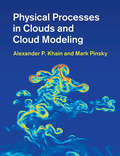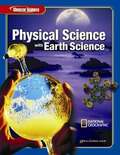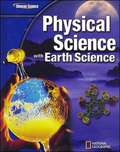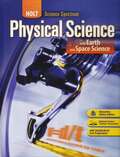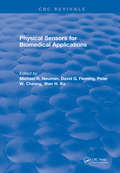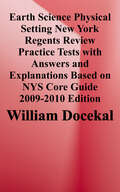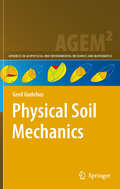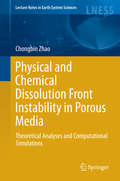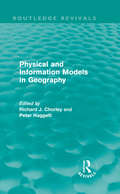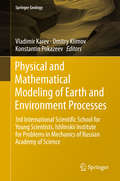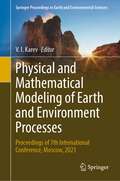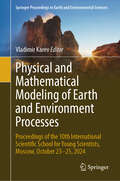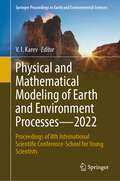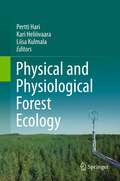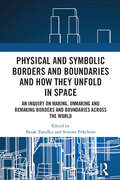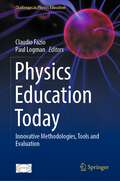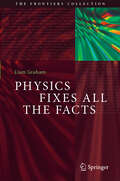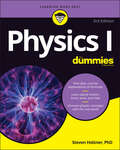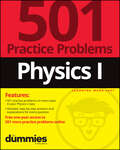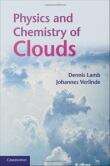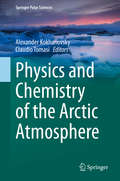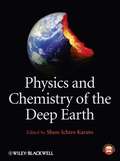- Table View
- List View
Physical Processes in Clouds and Cloud Modeling
by Alexander P. Khain Mark PinskyThis book presents the most comprehensive and systematic description currently available of both classical and novel theories of cloud processes, providing a much-needed link between cloud theory, observation, experimental results, and cloud modeling. This volume shows why and how modern models serve as a major tool of investigation of cloud processes responsible for atmospheric phenomena, including climate change. It systematically describes classical as well as recent advancements in cloud physics, including cloud-aerosol interaction; collisions of particles in turbulent clouds; and the formation of multiphase cloud particles. As the first of its kind to serve as a practical guide for using state-of-the-art numerical cloud models, major emphasis is placed on explaining how microphysical processes are treated in modern numerical cloud resolving models. The book will be a valuable resource for advanced students, researchers and numerical model designers in cloud physics, atmospheric science, meteorology, and environmental science.
Physical Science (South Carolina)
by Dinah Zike Charles William Mclaughlin Marilyn ThompsonGive every student a deeper understanding of physical science!. . Glencoe "Physical Science" integrates accurate and comprehensive coverage of physics and chemistry with mathematics through accessible text, engaging features, and a variety of hands-on experiences. The critical-thinking opportunities, real-world applications, and technology resources lead students to a deeper understanding of physical science, while building science process skills..
Physical Science with Earth Science
by Glencoe Mcgraw-HillPhysical Science with Earth provides students with accurate and comprehensive content coverage of physical science integrated with Earth science. This highly engaging integrated program brings together physics,chemistry, Earth science, space science, and mathematics. This course, together with a biology course, prepares students for many state/district graduation exams administered at 10th grade.
Physical Science with Earth Science
by National GeographicUnit 1: Science and Technology Unit 2: Motion, Forces and Energy Unit 3: Energy in Motion Unit 4: Forms of Energy Unit 5: Matter and Earth Materials Unit 6: Interactions of Matter
Physical Science: Concepts in Action
by Michael Wysession David Frank Sophia YancopoulosNIMAC-sourced textbook
Physical Science: Concepts in Action, With Earth and Space Science
by Michael Wysession Sophia Yancopoulos David V. FrankPhysical Science is the study of non-living systems, as opposed to a study of biological sciences or living systems. It consists of physics, chemistry, astronomy and earth science. It also includes scientific method and experimentation and this is what this textbook is all about.
Physical Science: With Earth and Space Science (Holt Science Spectrum)
by Rinehart and Winston HoltHolt Science Spectrum: Physical Science: With Earth and Space Science
Physical Sensors for Biomedical Applications
by Michael R. NeumanThe material in this book is based upon a two-day workshop on solid state physical sensors for biomedical applications held in Huron, Ohio, December 8-9, 1977. The individual sections of the book are based upon presentations made by the authors at the workshop. Each presentation was transcribed and given to the authors for revision. Also, transcribed, are the discussions had following each presentation.
Physical Setting Regents Earth Science Practice Tests
by William DocekalA practice Test Booklet that contains 4 full length NYS Regents Physical Setting Earth Science. This booklet has fully explained Answers and Reference Tables.Used to prepare high school students for the New York State Regents Physical Setting Earth Science.
Physical Soil Mechanics
by Gerd GudehusSoil is matter in its own right. Its nature can be captured by means of monotonous, cyclic and strange attractors. Thus material properties are defined by the asymptotic response of sand- and clay-like samples to imposed deformations and stresses. This serves to validate and calibrate elastoplastic and hypoplastic relations with comparative plots. Extensions capture thermal and seismic activations, limitations occur due to localizations and skeleton decay.Attractors in the large characterize boundary value problems from model tests via geotechnical operations up to tectonic evolutions. Validations of hypoplastic calculations are shown with many examples, possible further applications are indicated in detail. This approach is energetically justified and limited by critical points where the otherwise legitimate continuity gets lost by localization and decay. You will be fascinated by the fourth element although or just as it is so manifold.
Physical and Chemical Dissolution Front Instability in Porous Media
by Chongbin ZhaoThis monograph provides state-of-the-art theoretical and computational findings from investigations on physical and chemical dissolution front instability problems in porous media, based on the author's own work. Although numerical results are provided to complement theoretical ones, the focus of this monograph is on the theoretical aspects of the topic and those presented in this book are applicable to a wide range of scientific and engineering problems involving the instability of nonlinear dynamic systems. To appeal to a wider readership, common mathematical notations are used to derive the theoretical solutions. The book can be used either as a useful textbook for postgraduate students or as a valuable reference book for computational scientists, mathematicians, engineers and geoscientists.
Physical and Information Models in Geography (Routledge Revivals)
by Richard J. Chorley Peter HaggettFirst published in 1967, this book explores the theme of geographical generalization, or model building. It is composed of eight of the chapters from the original Models in Geography, published in 1967. The first chapter broadly outlines geographical generalization and examines the nature and function of generalized statements, ranging from conceptual models to scale models, in a geographical context. The following chapter deals with model theory in a wider scientific framework and the rest of the book discusses models of physical systems and information models. The book considers model-type generalizations that are applied in the three fields of geomorphology, meteorology and climatology, and hydrology before focusing on the transference of information and ideas in geography. This text represents a robustly anti-idiographic statement of modern work in one of the major branches of geography.
Physical and Mathematical Modeling of Earth and Environment Processes: 3rd International Scientific School For Young Scientists, Ishlinskii Institute For Problems In Mechanics Of Russian Academy Of Science (Springer Geology)
by Vladimir Karev Dmitry Klimov Konstantin PokazeevThis book is the result of collaboration within the framework of the Third International Scientific School for Young Scientists held at the Ishlinskii Institute for Problems in Mechanics of Russian Academy of Sciences, 2017, November. The papers included describe studies on the dynamics of natural system – geosphere, hydrosphere, atmosphere—and their interactions, the human contribution to naturally occurring processes, laboratory modeling of earth and environment processes, and testing of new developed physical and mathematical models. The book particularly focuses on modeling in the field of oil and gas production as well as new alternative energy sources.
Physical and Mathematical Modeling of Earth and Environment Processes: Proceedings of 7th International Conference, Moscow, 2021 (Springer Proceedings in Earth and Environmental Sciences)
by V. I. KarevThis book presents short papers of participants of the 7th International Scientific Conference-School for Young Scientists "Physical and Mathematical Modeling of Earth and Environment Processes" (Ishlinsky Institute for Problems in Mechanics of the Russian Academy of Sciences). The book includes theoretical and experimental studies of processes in the atmosphere, oceans, the lithosphere, and their interaction; environmental issues; problems of human impact on the environment; and methods of geophysical research.
Physical and Mathematical Modeling of Earth and Environment Processes: Proceedings of the 10th International Scientific School for Young Scientists, Moscow, October 18–20, 2024 (Springer Proceedings in Earth and Environmental Sciences)
by Vladimir KarevThe book presents short papers of participants of the 10th International Scientific Conference and School for Young Scientists «Physical and Mathematical Modeling of Earth and Environment Processes. The book includes theoretical and experimental studies of processes in the atmosphere, oceans, the lithosphere and their interaction; environmental issues; problems of human impact on the environment; methods of geophysical research. Research of the dynamic of natural systems - geosphere, hydrosphere, atmosphere and their interactions, the human contribution to naturally occurring processes are among the most urgent and practically important scientific problems. Intensive development of research in these areas is due to several factors. The widespread introduction of computer technology has allowed beginning calculation of complex phenomena, previously unavailable for analysis. Creation and improvement of a new generation of geophysical instruments, remote observing systems based on the ship, aircraft, and satellite allowed us to obtain a large amount of data to objectively reflect the picture of the processes. The articles included in these book reflect also an important role of the laboratory modeling in searching of processes in geo-environments and testing of new developed physical and mathematical models. Development of measurement, optic information and other techniques provide new opportunities to perform controllable and reproducible laboratory data for generations of new ideas and concepts. Systematic stream of high resolution laboratory data stimulates development of analytical and numerical models of the dynamical processes in three nature environments. A special focus is given to the extraction of hydrocarbon resources, including from unconventional sources. An alternative to the use of hydrocarbons as a main source of energy on the Planet in the coming decades is unlikely to be found. At the same time, the resource base of hydrocarbons is quickly depleted, in particularly, large and accessible oil and gas fields. The shale oil and gas, Arctic hydrocarbon stocks, gas hydrates, coal bed methane, oil and gas from deep horizons can become new sources.
Physical and Mathematical Modeling of Earth and Environment Processes—2022: Proceedings of 8th International Scientific Conference-School for Young Scientists (Springer Proceedings in Earth and Environmental Sciences)
by V. I. KarevThe book presents short papers of participants of the 8th International Scientific Conference-School for Young Scientists "Physical and Mathematical Modeling of Earth and Environment Processes" (Ishlinsky Institute for Problems in Mechanics of the Russian Academy of Sciences). The book includes theoretical and experimental studies of processes in the atmosphere, oceans, the lithosphere and their interaction; environmental issues; problems of human impact on the environment; methods of geophysical research.
Physical and Physiological Forest Ecology
by Kari Heliövaara Liisa Kulmala Pertti HariThis book introduces a holistic synthesis of carbon and nitrogen fluxes in forest ecosystems from cell to stand level during the lifetime of trees. Establishing that metabolism and physical phenomena give rise to concentration, pressure and temperature differences that generate the material and energy fluxes between living organisms and their environment. The editors and authors utilize physiological, physical and anatomical background information to formulate theoretical ideas dealing with the effects of the environment and the state of enzymes, membrane pumps and pigments on metabolism. The emergent properties play an important role in the transitions from detailed to more aggregate levels in the ecosystem. Conservation of mass and energy allow the construction of dynamic models of carbon and nitrogen fluxes and pools at various levels in the hierarchy of forest ecosystems.
Physical and Symbolic Borders and Boundaries and How They Unfold in Space: An Inquiry on Making, Unmaking and Remaking Borders and Boundaries Across the World
by Basak Tanulku Simone PekelsmaThis book critically examines how borders and boundaries, physical and symbolic, unfold in different geographies and spaces. It aims to understand why they exist and how they are constructed, deconstructed, and reconstructed.The book explores why certain borders/boundaries persist while others are removed, and new ones are erected. It does not focus on one form of border, boundary or geographic location. It shifts its attention to different geographies, borders, and boundaries. It also focuses on intersections between them and how they complete each other. The book provides case studies from the past and present, allowing readers to connect subjects, periods, and geographies. The chapters address classical subjects such as nation-states and tackle novel questions such as ownership against access, that is, of urban infrastructures, COVID-19 and lockdowns, and the divides within digital worlds. The book benefits from visual essays that complement the theoretical and empirical chapters, showing the complexity of the phenomenon in a simple and effective way.The book will be of interest to academics, researchers, and students working in the fields of urban and rural studies, urban sociology, cities and communities, urban and regional planning, urban anthropology, political sciences and migration studies, human geography, cultural geography, urban anthropology, and visual arts.
Physics Education Today: Innovative Methodologies, Tools and Evaluation (Challenges in Physics Education)
by Claudio Fazio Paul LogmanThis book provides an in-depth exploration of the latest developments in physics education. It presents a comprehensive look into cutting-edge research and ideas used to improve physics education around the world. Topics covered include (but are not limited to) the use of problem-based learning, the design and evaluation of teaching materials, and the use of digital technologies. This book is essential for anyone looking to stay up-to-date on the latest educational innovations and to develop an understanding of effective teaching approaches. It is aimed at researchers, teachers, students, policymakers, and educational leaders in the field of physics education.
Physics Fixes All the Facts (The Frontiers Collection)
by Liam GrahamComplex systems seem to magically emerge from the interactions of their parts. A whirlpool emerges from water molecules. A living cell from organic molecules. You emerge from the cells of your body. Not since chaos has a concept from physics spread like wildfire to other disciplines. Emergence can be found from chemistry to economics; from psychology to ecology. At its heart is the alluring idea that there’s more to the world than physics, that there is a holistic component to nature, an edge of mystery. “Physics Fixes All the Facts” starts by taking you on a tour through a fascinating world of complexity, exploring phenomena from the inside of an atomic nucleus to bacterial behaviour to the ability of your thoughts to affect the world. These examples are used along with a thorough exploration of the philosophical literature to untangle the notoriously poorly defined concept of emergence. This reveals something surprising: the term emergence is redundant. In its weak form it is so weak that it applies to everything. In its strong form it is so restrictive that it is like the belief that there are pixies in your garden, impossible to exclude but not worth spending your time on. Emergence either applies to all systems or to none. Rather than telling us something about the nature of the world, it is an illusion, an artefact of our cognitive limitations. The past decade has seen a dozen or so monographs and collections about emergence, almost all resolutely supportive of the concept. This book aims to redress the balance. But it is more than just a campaign against the idea of emergence. Graham presents a framework called Austere Physicalism and argues that it is the only coherent way to view the world. He uses this framework to reinterpret so-called emergent phenomena and investigates its wider implications for science. In this radically materialist view, we are nothing but physical systems among others. “Physics Fixes All the Facts” ends by exploring what this means for our sense of free will and consciousness. The book will appeal to academics in fields which use the concepts of complexity or emergence. Scientists and philosophers alike will find unexpected and exciting ideas in these pages. But the target audience is much broader including students who want to add context to their studies and the intellectually curious with some scientific background.
Physics I For Dummies
by Steven HolznerAn easy-to-follow guide to introductory physics, from the Big Bang to relativity All science, technology, engineering, and math majors in college and university require some familiarity with physics. Other career paths, like medicine, are also only open to students who understand this fundamental science. But don’t worry if you find physics to be intimidating or confusing. You just need the right guide! In Physics I For Dummies, you’ll find a roadmap to physics success that walks you through every major topic in introductory physics, including motion, energy, waves, thermodynamics, electromagnetism, relativity, and more. You’ll learn the basic principles and math formulas of physics through clear and straightforward examples and instruction, and without unnecessary jargon or complicated theory. In this book, you’ll also find: Up-to-date examples and explanations appearing alongside the latest discoveries and research in physics, discussed at a level appropriate for beginning students All the info found in an intro physics course, arranged in an intuitive sequence that will give first-year students a head start in their high school or college physics class The latest teaching techniques to ensure that you remember and retain what you read and practice in the bookPhysics I For Dummies is proof that physics can fun, accessible, challenging, and rewarding, all at the same time! Whether you’re a high school or undergraduate student looking for a leg-up on basic physics concepts or you’re just interested in how our universe works, this book will help you understand the thermodynamic, electromagnetic, relativistic, and everything in between.
Physics I: 501 Practice Problems For Dummies (+ Free Online Practice)
by The Experts at DummiesOvercome your study inertia and polish your knowledge of physics Physics I: 501 Practice Problems For Dummies gives you 501 opportunities to practice solving problems from all the major topics covered you Physics I class—in the book and online! Get extra help with tricky subjects, solidify what you’ve already learned, and get in-depth walk-throughs for every problem with this useful book. These practice problems and detailed answer explanations will help you succeed in this tough-but-required class, no matter what your skill level. Thanks to Dummies, you have a resource to help you put key concepts into practice. Work through practice problems on all Physics I topics covered in school classes Step through detailed solutions to build your understanding Access practice questions online to study anywhere, any time Improve your grade and up your study game with practice, practice, practiceThe material presented in Physics I: 501 Practice Problems For Dummies is an excellent resource for students, as well as parents and tutors looking to help supplement Physics I instruction. Physics I: 501 Practice Problems For Dummies (9781119883715) was previously published as Physics I Practice Problems For Dummies (9781118853153). While this version features a new Dummies cover and design, the content is the same as the prior release and should not be considered a new or updated product.
Physics and Chemistry of Clouds
by Dennis Lamb Johannes VerlindeClouds affect our daily weather and play key roles in the global climate. Through their ability to precipitate, clouds provide virtually all of the fresh water on Earth and are a crucial link in the hydrologic cycle. With ever-increasing importance being placed on quantifiable predictions – from forecasting the local weather to anticipating climate change – we must understand how clouds operate in the real atmosphere, where interactions with natural and anthropogenic pollutants are common. This textbook provides students – whether seasoned or new to the atmospheric sciences – with a quantitative yet approachable path to learning the inner workings of clouds. Developed over many years of the authors' teaching at Pennsylvania State University, Physics and Chemistry of Clouds is an invaluable textbook for advanced students in atmospheric science, meteorology, environmental sciences/engineering and atmospheric chemistry. It is also a very useful reference text for researchers and professionals.
Physics and Chemistry of the Arctic Atmosphere (Springer Polar Sciences)
by Claudio Tomasi Alexander KokhanovskyThis book presents current knowledge on chemistry and physics of Arctic atmosphere. Special attention is given to studies of the Arctic haze phenomenon, Arctic tropospheric clouds, Arctic fog, polar stratospheric and mesospheric clouds, atmospheric dynamics, thermodynamics and radiative transfer as related to the polar environment. The atmosphere-cryosphere feedbacks and atmospheric remote sensing techniques are presented in detail. The problems of climate change in the Arctic are also addressed.
Physics and Chemistry of the Deep Earth
by Shun-Ichiro KaratoThough the deep interior of the Earth (and other terrestrial planets) is inaccessible to humans, we are able to combine observational, experimental and computational (theoretical) studies to begin to understand the role of the deep Earth in the dynamics and evolution of the planet. This book brings together a series of reviews of key areas in this important and vibrant field of studies.A range of material properties, including phase transformations and rheological properties, influences the way in which material is circulated within the planet. This circulation re-distributes key materials such as volatiles that affect the pattern of materials circulation. The understanding of deep Earth structure and dynamics is a key to the understanding of evolution and dynamics of terrestrial planets, including planets orbiting other stars.This book contains chapters on deep Earth materials, compositional models, and geophysical studies of material circulation which together provide an invaluable synthesis of deep Earth research.Readership: advanced undergraduates, graduates and researchers in geophysics, mineral physics and geochemistry.
